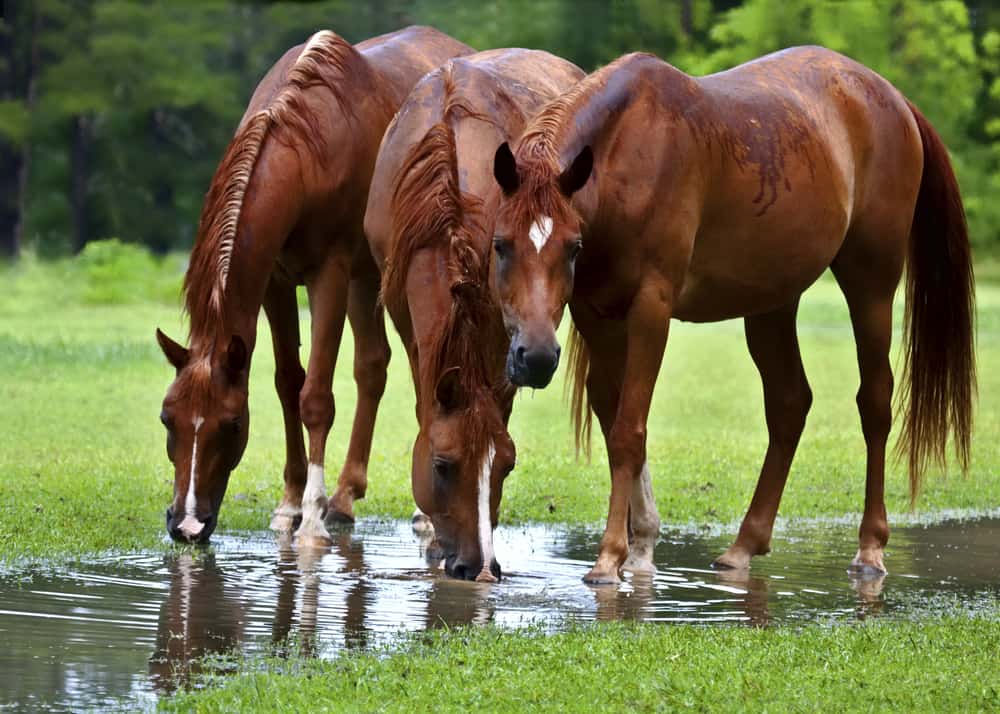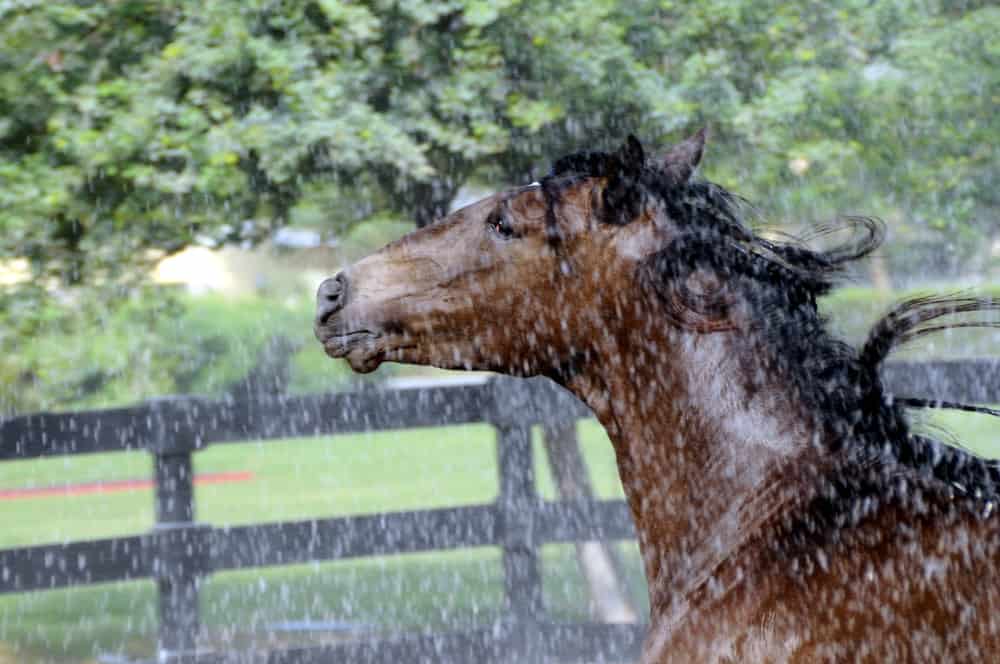- Your source for stall mats, rubber arena footing, arena harrows and arena dust control.

Rainwater is from nature and it is free, it doesn’t cost anything. It is one of the renewable sources of water. Water from the sky is fresher than water from a water treatment facility. However, can rainwater harvesting be used to supply drinking water for your horses ?
?
Giving your horse rainwater to drink is perfectly safe. Rainwater is the cleanest supply of water that comes from nature. However, the challenge is to collect and storing the rainwater correctly to keep it as fresh as possible to give your horses to drink.
If you’re looking to save on water costs and become more efficient, then collecting rainwater is an excellent idea for your stables. Here we explain everything you need to know about collecting rainwater for your horses.
How safe is rainwater for my horses?
Many equestrian businesses are looking to become more efficient, greener, and more self-reliant. Collecting rainwater is the perfect solution for equestrian facilities where water usage can be high. You need water for feeding, washing, and soaking hay, so it will be highly beneficial when you can reduce any of these water costs.
Rainwater run-off collected from a roof can provide you with soft, clear, and low-salinity water. Water from a correctly installed and maintained rainwater system usually is safe for livestock and domestic use.
The guidelines and information listed here will help you avoid poorly installed and inadequately maintained systems resulting in contaminated water and possible health problems.
Rainwater is perfectly safe for your horse to drink, just as long as you collect it safely, keep it clean and store it correctly. As soon as the rainwater hits your stable roof, it is subjected to contamination by pollutants deposited on your roof.
Animals, insects, leaves, leaching, and dissolving material that the roof is made of can all contaminate and influence the quality of drinking rainwater. Just about anything can be blown or dropped onto your roof in some form or another over time.
How to collect rainwater safely for your horses
Rainwater is clean and safe and doesn’t get contaminated to the point of being a health issue until it hits the roof or ground.
The collection of rainwater is known throughout the world by many names. It is known as rainwater collection, rainwater catchment, rainwater harvesting, and rooftop water collection.
Even though rainwater collection is an old technology, many improvements were made over time through product innovations. Collecting rainwater is one of the most effective ways to have a safe, clean water supply for your horses.
To collect rainwater, you can place tanks above the ground next to your house or barn. The roof will catch the rainwater, and with pipes connected to your gutters, divert the rainwater into your rainwater collection tank.
Roofs made of corrugated metalwork or tin works best. Thatch roofs may collect too much dirt, and the water may not be safe to drink. Avoid collecting rainwater from roofs made of lead or tar; they can have toxic chemicals that will make the water unsafe for drinking. Ensure your rainwater barrel is clean and never used to store any harmful chemicals, like oil or pesticides.
How to keep the collected rainwater clean
Collected rainwater must be kept clean and free of contamination to be safe for your horses to drink. Follow these steps to make sure the rainwater you collect will be safe to use:
- Thoroughly clean your tank, entrance pipe, roof, and roof gutters before the rainy season.
- Let the first rain of each year run entirely through the tank to clean it. Most people who collect rainwater agree that it is a good practice to eliminate the first few gallons of rainwater collected from the roof. This is called the first wash and cleans out your tank.
- Cover your tank and place a filter or screen over the inlets to keep out leaves, insects, and dirt. Covering your tank will prevent mosquitoes from breeding in the water.
- Install a tap in your water tank and take out the water through the fixtures. If you use buckets or other containers to remove water, make sure they are spotless to not dirty the water.
- Never collect rainwater in containers that were used for pesticides, oil, or other toxic chemicals.
- For added safety, you can connect a water filter to your tank.
- Do not move or stir the water. That way, if any dirt is in the tank, it will settle and stay at the bottom.
- To minimize the growth of algae, exclude sunlight from the rainwater tank as much as possible. Make sure your inspection lids and access points are tightfitting.
- It is an excellent idea to de-sludge your water tank every 2 to 3 years or when necessary. With galvanized iron tanks, make sure not to disturb the film that builds upon the wall inside the tank because it protects the metal from corrosion.
- Ensure sweeping your roof from time to time to remove any debris that might have landed on the roof; this will also help keep collected rainwater clean.

Use safe roofing materials to collect your rainwater for your horses
Safe roof materials that you can use include:
- Cement.
- Terracotta tiles.
- Zincalume.
- Galvanized Iron.
- Polycarbonate.
- Slate.
- Fiberglass sheeting.
After manufacturing, surface deposits can remain and might be present on most new roofs, tanks, and gutters, so allow the run-off from the first rainstorms to run to waste to clean your system.
Lime can leach from concrete tiles, asbestos cement roofing, and concrete tanks, which can cause some increased hardness and alkalinity of the rainwater. This lime will usually disappear in the first twelve months. The lowered water quality is typically safe to drink during this time, but have your water tested if you have any concerns.
Do not use any of these unsafe roofing materials to collect rainwater for your horses
Unsafe roofing materials include:
- Do not use chemically treated wood with copper chrome, pentachlorophenol, or creosote.
- Bituminous Products.
- Roof with discharge pipes from roof-mounted appliances, like hot water systems or evaporative air conditioners.
- Do not use any gutters or flashings that are painted with lead-based paints for rainwater collection.
- Do not use a roof to collect water near a chimney from a wood burner stove or fireplace.
How to filter rainwater safely
Not every natural water source is problematic, and not all provided water is safe. Keep a careful watch over the water your horses are drinking to detect contamination issues before they cause illness, dehydration, or colic for your horses.
If you want to make double sure the rainwater you collected is entirely safe for your horses to drink, you can always disinfect the rainwater. Rainwater is disinfected through the use of ultraviolet (UV) light. In Europe, this method has been used for almost a century and is now also popular and being used in the United States.
With the UV light disinfecting method, the rainwater will pass first in a filtration system. The UV light penetrates the organisms’ cell walls and prevents their reproduction, making them harmless. The UV light does not change the water’s chemical composition, and it does not leave any by-products on it.
Here are more ways to filter rainwater safely:
- Cartridge filters. The cartridge filter system needs to be changed regularly to prevent microorganisms from living in a dirty environment. For rainwater systems, you require a large filter which is 50 microns or more, to eliminate the insects, sand, pebbles, and other larger particles.
- Chlorine. Chlorine has eliminated several water-borne diseases like dysentery, hepatitis, typhoid, and cholera. Chlorine has saved the lives of thousands of people. However, chlorine also has side effects; that’s why many people are hesitant with its use. Remove the by-products of chlorine by using another purification process, such as reverse osmosis. Installing an activated carbon filter or charcoal filter will remove the smell and taste of chlorine. This system is made from coconut shells and carbon, entirely environmentally safe.
- Solar pasteurization. This method of filtering rainwater is through solar pasteurization; however, this system is labor-intensive and unlike all other ways.
Conclusion
Rainwater is perfectly safe for your horses to drink when it is collected safely and stored correctly. With proper care and maintenance, roof catchment of rainwater is an excellent source of drinking water for your horses.
A rainwater collection system is a perfect answer and investment for many stables, and once the system is installed is highly effective and cost-saving. The rainwater collection system will collect rainwater in under or above-ground tanks, ready for use at your stables.
There are many methods of harvesting rainwater, and it has been used for many years. Apart from these methods, there are also many ways to filter rainwater.
Rainwater collection is excellent for equestrian facilities where water consumption is usually high, so many stable yards are looking to reduce their water costs and be as efficient as possible. Most equestrian stables are looking for a greener, more efficient, and self-reliant water system and rainwater collection is a perfect solution.

